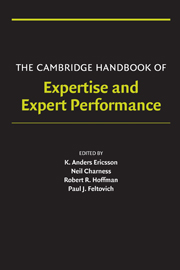Book contents
- Frontmatter
- Contents
- Acknowledgments
- Contributors
- PART I INTRODUCTION AND PERSPECTIVE
- PART II OVERVIEW OF APPROACHES TO THE STUDY OF EXPERTISE – BRIEF HISTORICAL ACCOUNTS OF THEORIES AND METHODS
- 4 Studies of Expertise from Psychological Perspectives
- 5 Educators and Expertise: A Brief History of Theories and Models
- 6 Expert Systems: A Perspective from Computer Science
- 7 Professionalization, Scientific Expertise, and Elitism: A Sociological Perspective
- PART III METHODS FOR STUDYING THE STRUCTURE OF EXPERTISE
- PART IV METHODS FOR STUDYING THE ACQUISITION AND MAINTENANCE OF EXPERTISE
- PART V DOMAINS OF EXPERTISE
- PART VI GENERALIZABLE MECHANISMS MEDIATING EXPERTISE AND GENERAL ISSUES
- Author Index
- Subject Index
- References
7 - Professionalization, Scientific Expertise, and Elitism: A Sociological Perspective
from PART II - OVERVIEW OF APPROACHES TO THE STUDY OF EXPERTISE – BRIEF HISTORICAL ACCOUNTS OF THEORIES AND METHODS
- Frontmatter
- Contents
- Acknowledgments
- Contributors
- PART I INTRODUCTION AND PERSPECTIVE
- PART II OVERVIEW OF APPROACHES TO THE STUDY OF EXPERTISE – BRIEF HISTORICAL ACCOUNTS OF THEORIES AND METHODS
- 4 Studies of Expertise from Psychological Perspectives
- 5 Educators and Expertise: A Brief History of Theories and Models
- 6 Expert Systems: A Perspective from Computer Science
- 7 Professionalization, Scientific Expertise, and Elitism: A Sociological Perspective
- PART III METHODS FOR STUDYING THE STRUCTURE OF EXPERTISE
- PART IV METHODS FOR STUDYING THE ACQUISITION AND MAINTENANCE OF EXPERTISE
- PART V DOMAINS OF EXPERTISE
- PART VI GENERALIZABLE MECHANISMS MEDIATING EXPERTISE AND GENERAL ISSUES
- Author Index
- Subject Index
- References
Summary
Introduction
A key principle of sociology is that the lives of individuals cannot be understood without considering the social contexts in which the individuals live. Sociology is both a science and humanistic discipline that examines explanations based on structure, culture, discourse, and action dimensions in order to understand and interpret human behavior, beliefs, and expectations. This chapter will therefore examine the social contexts for, and different interpretations of, expertise, particularly within the context of professional work, science, and politics.
From a psychological point of view, expertise may be studied without respect to social contexts (Feltovich, Prietula, & Ericsson, Chapter 4). In contrast to this, sociology concerns itself with contextual conditions of the development of expertise and its functions in modern societies. From a sociological point of view, expertise and experts are relational notions: to be an expert always means to be an expert in contrast to nonexperts, that is, to laypersons (see also Mieg, Chapter 41). The dichotomy between experts and laypersons often implies not only a gradient of expertise, but also gradients in other social dimensions, such as prestige, privileges, and power. Sociological propositions about experts and expertise generally refer to this dichotomy.
Section One of this chapter deals with professions as the main form of an institutionalization of expertise in industrialized countries, the most prominent being lawyers and the medical profession. As we will see, professions can be analyzed as a generic group of occupations based on knowledge and expertise, both technical and tacit.
- Type
- Chapter
- Information
- The Cambridge Handbook of Expertise and Expert Performance , pp. 105 - 124Publisher: Cambridge University PressPrint publication year: 2006
References
- 44
- Cited by



